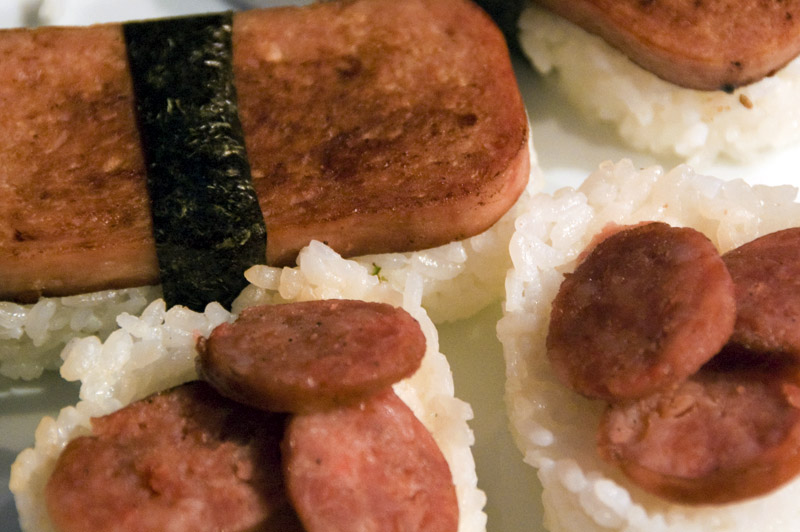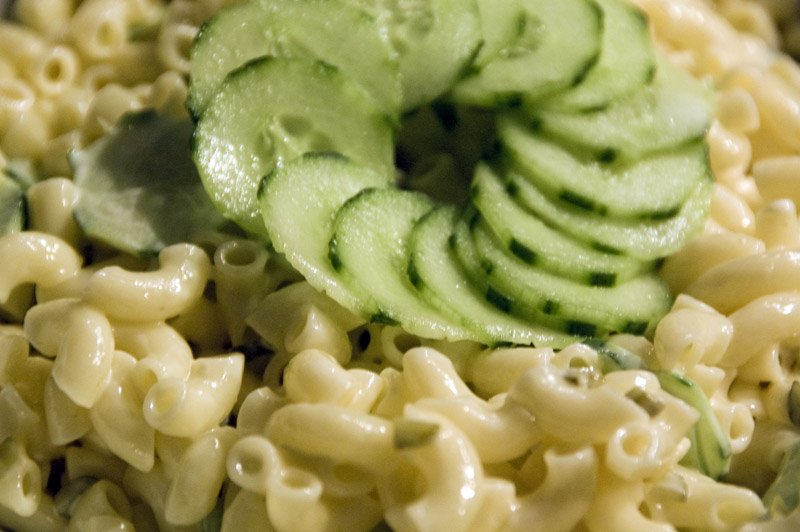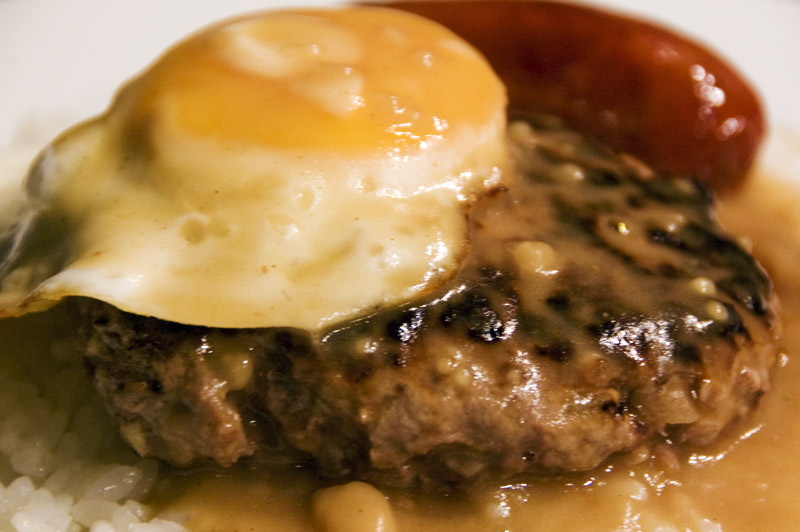And this, despite our best efforts, is probably faux Hawaiian food.
Neither of us are Hawaiian. I think Alannah's been there once. I've never even been. But back in California, we have a good number of Hawaiian friends, and one unattainable thing we really crave every once in a while is Hawaiian food.
We were walking through Paris' Chinatown the previous weekend, and like every time, were disappointed when passing by a restaurant called Hawai. Looking at the menu, it's all standard Sino-Vietnamese fare. No loco moco. No kalua pig. Not even a single taro root. In fact, it's probably pronounced "Hah-way" and our fantasies of gravy-slathered beef, pulled pork, and starch overload are just a bout of wishful thinking... At that point, we both thought, "We really need to cook up a Hawaiian feast sometime."
This last weekend we found some more off-the-beaten path ethnic stores (including a handful of tiny Filipino markets in the ritzy 16th arrondissement) and, as it turns out, wound up with what it takes to make an authentic Hawaiian meal. No, not an entire pig to roast in a sandpit under banana leaves, but that other Island staple: Spam.
The South Pacific has a longstanding love affair with the canned lunchmeat that's been ridiculed for decades by Johnny Carson and Monty Python. Our friend Arnold over at Inuyaki has an archive of articles on Spam. Frankly, I still find it utterly disgusting. But as soon as we saw the iconic blue can on the shelf of the Marché Manille, Alannah and I turned to each other and said in unison, "Spam musubi!"
We were walking through Paris' Chinatown the previous weekend, and like every time, were disappointed when passing by a restaurant called Hawai. Looking at the menu, it's all standard Sino-Vietnamese fare. No loco moco. No kalua pig. Not even a single taro root. In fact, it's probably pronounced "Hah-way" and our fantasies of gravy-slathered beef, pulled pork, and starch overload are just a bout of wishful thinking... At that point, we both thought, "We really need to cook up a Hawaiian feast sometime."
This last weekend we found some more off-the-beaten path ethnic stores (including a handful of tiny Filipino markets in the ritzy 16th arrondissement) and, as it turns out, wound up with what it takes to make an authentic Hawaiian meal. No, not an entire pig to roast in a sandpit under banana leaves, but that other Island staple: Spam.
 |
| Spam musubi and Longanisa onigiri |
Musubi is another term for the Japanese snack onigiri. (Many Hawaiian dishes, I've found, are derived from what I grew up with as Japanese comfort foods.) It's basically a bundle or brick of cold or room-temperature rice stuffed or topped with some sort of non-rice substance. In this case, that non-rice, non-food, non-organic substance is a fried slice of Spam. And it's magical. You can eat it warm. You can eat it cold. You can probably eat it 20 years from now.
NOTE: As conscientious foodies, we try to buy as much organic/locally produced/artisan product as possible. While it's still somewhat inexcusable, we were relieved to learn that this UK-sourced Spam is actually made under license in Denmark using European hog parts. For what it's worth, at least it's all EU.
Of course, with the guy at the Filipino store having hooked us up with some of his buddy's homemade Longanisa, we had to honor his coolness by making some onigiri with said sweet sausage as well. Not to mention it's perfectly fitting, as Filipino foods are as much a part of the Hawaiian melting pot as Japanese, Chinese and mainland. (Or so the menu at the L&L Hawaiian Barbecue chain informs me.)
Despite the setback in bequeathing it with official endangered status, the recent brouhaha over the scarcity of bluefin tuna (which is rarely served or sold in the mainstream marketplace), has seemd to make the price of all tuna go up. Despite the rather ridiculous prices, when I saw some beautiful, deeply-colored, sashimi-grade tuna at our local Sunday market, I had to pony up. All for one dish that'll get hoovered up in two seconds: Poké.
Poké is a Polynesian variant on sashimi or ceviche. You take your fresh fish, slice it up into strips or dice it into cubes, and let it marry with a blend of soy sauce, sesame oil, chilis, and sweet onion. Simple but fantastic. Like with many raw fish dishes like ceviche, it goes really well with a contrasting side like guacamole – or simply sliced avocados. But it's good enough to have straight up. I like to think of it as the steak tartare of the sea.
Going by experiences like the aforementioned L&L (or San Francisco's legendary Hawaiian sit-down, Da Hukilau), no platter of Hawaiian food is complete without a rich, mayonnaise-y macaroni salad. Like Spam, mayonnaise is one of those things where it takes an exception for me to like. Those exceptions are Japanese Kewpie-brand mayonnaise and the homemade stuff.
For this salad, while Kewpie would've been perfect, we simply went with making our own, which is easy: Hand-beat the ever-loving crap out of one egg yolk with a touch of vinegar, slowly adding standard salad oil (olive, peanut, etc.) until it gets to the volume and consistency you like. The approximate ratio is around 200ml (just under one cup) per egg yolk. You can use a machine, but everyone knows a good whipping by hand is where it's at.
We used less mayo than we're accustomed to from Hawaiian joints back on the Left Coast, and even lightened it up with some thinly sliced Japanese-style cucumber to give it some freshness.
Of course, a cholesterol-heavy side dish needs an even more fat-laden main course to accompany it. And there's no Hawaiian meal easier or more satisfying to make than loco moco. Take a pile of steamed Japanese rice, top it with a hamburger patty, top that with a fried egg, and then smother it all with brown gravy. If you're insane like we are, add a link of longanisa on the side, just to seal your doom.
This was no ordinary loco moco, though. We used top grade Japanese rice made in filtered water, grade "01" eggs (the top French classification for free-range, cage-free, blah blah blah), and freshly ground steak from our local butcher (that I'd mixed with finely diced sweet onion). The result was the most amazing tasting loco moco we've ever had – largely due to the crazy hambagu steak (as they'd say in Japanese) patty. After the musubi and the onigiri and the poké and the macaroni salad, this was all just overkill.
But, well, that's what a Hawaiian feast is all about. Celebrating the abundance of starch, flesh, fat and sugar that can find its way on to an island chain in the Pacific. Or the Ile-de-France region around Paris.
That's kind of sort of an Island, right?
NOTE: As conscientious foodies, we try to buy as much organic/locally produced/artisan product as possible. While it's still somewhat inexcusable, we were relieved to learn that this UK-sourced Spam is actually made under license in Denmark using European hog parts. For what it's worth, at least it's all EU.
Of course, with the guy at the Filipino store having hooked us up with some of his buddy's homemade Longanisa, we had to honor his coolness by making some onigiri with said sweet sausage as well. Not to mention it's perfectly fitting, as Filipino foods are as much a part of the Hawaiian melting pot as Japanese, Chinese and mainland. (Or so the menu at the L&L Hawaiian Barbecue chain informs me.)
Despite the setback in bequeathing it with official endangered status, the recent brouhaha over the scarcity of bluefin tuna (which is rarely served or sold in the mainstream marketplace), has seemd to make the price of all tuna go up. Despite the rather ridiculous prices, when I saw some beautiful, deeply-colored, sashimi-grade tuna at our local Sunday market, I had to pony up. All for one dish that'll get hoovered up in two seconds: Poké.
 |
| Don't worry, it's not endangered bluefin. We can't afford dat shit, brudda. |
 |
| These cucumbers are here for the sake of not dying of heart failure before the meal is over. |
For this salad, while Kewpie would've been perfect, we simply went with making our own, which is easy: Hand-beat the ever-loving crap out of one egg yolk with a touch of vinegar, slowly adding standard salad oil (olive, peanut, etc.) until it gets to the volume and consistency you like. The approximate ratio is around 200ml (just under one cup) per egg yolk. You can use a machine, but everyone knows a good whipping by hand is where it's at.
We used less mayo than we're accustomed to from Hawaiian joints back on the Left Coast, and even lightened it up with some thinly sliced Japanese-style cucumber to give it some freshness.
 |
| Heart attack on a plate. |
This was no ordinary loco moco, though. We used top grade Japanese rice made in filtered water, grade "01" eggs (the top French classification for free-range, cage-free, blah blah blah), and freshly ground steak from our local butcher (that I'd mixed with finely diced sweet onion). The result was the most amazing tasting loco moco we've ever had – largely due to the crazy hambagu steak (as they'd say in Japanese) patty. After the musubi and the onigiri and the poké and the macaroni salad, this was all just overkill.
But, well, that's what a Hawaiian feast is all about. Celebrating the abundance of starch, flesh, fat and sugar that can find its way on to an island chain in the Pacific. Or the Ile-de-France region around Paris.
That's kind of sort of an Island, right?


Thanks for the shout out. Love the longanisa onigiri, and good job finding a real Filipino market that hooks you up with special longanisa.
ReplyDeleteAnd the loco moco looks great. How was the longanisa mixed with gravy? :)
The shout out is obligatory - one cannot write about Spam and not reference your extensive works ;)
ReplyDeleteLonganisa with gravy - though I figured might not really work - was actually good, especially when mixed with the semi-runny part of the egg yolk. I guess, if anything, each bite was a bit like a longsilog with extra salt & fat!
I love this! As a Filipina-American living in the Netherlands I can totally relate to the ingredients hunt. And once I found panko and bulldog sauce, I now make chicken katsu (my all-time fave plate lunch item) at least once a week. (here's a link to my post on that one!)
ReplyDeleteThanks Sheryl! Heading over there right now. Chicken katsu curry is actually one of our house staples, though one I've been actively reducing so as not to overeat, which is all too easy with that stuff.
ReplyDelete